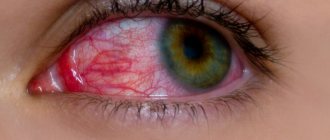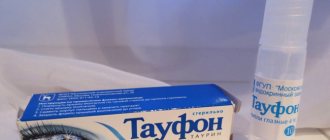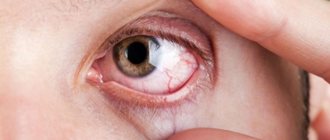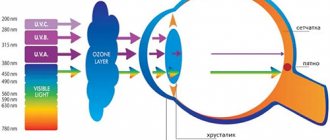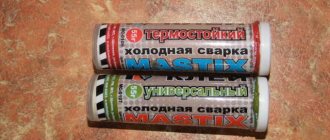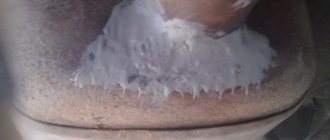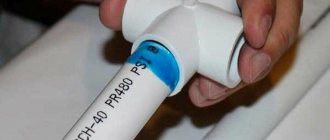Symptoms
Most often, electroophthalmia occurs when safety rules that are necessary when working with welding are not followed. When working with this device, it is extremely important to protect your face and eyes using special glasses or a mask.
If you neglect the rules, you are likely to develop electroophthalmia and retinal burns.
Symptoms of the disease are determined by the severity of the burn. There are four degrees of severity:
- With a mild burn, there is redness of the mucous membrane, itching, and burning. There is a decrease in corneal transparency.
- The average degree of burn injury is accompanied by pain and photophobia. A film forms on the surface of the conjunctiva and corneal erosion develops.
- Severe eye damage from welding is characterized by decreased visual acuity and significant clouding of the cornea. The eyelid tissue becomes swollen, and severe pain appears. In addition, the patient experiences discomfort and a feeling of a foreign body in the eye.
- Fourth degree burn damage leads to tissue necrosis. The patient complains of severe pain and cannot open his eyes. Rejection of conjunctival tissue also occurs. Sometimes blindness develops, and the corneal tissue becomes faded and colorless.
Four degrees of electrophthalmia
Mild degree. Accompanied by burning and itching, redness of the conjunctival membrane, reddening, slight and completely reversible clouding of the cornea (not always).
Average degree. There is a pronounced sensation of pain, severe redness of the conjunctiva, and severe photophobia. A film appears on the conjunctiva and the cornea becomes covered with ulcers.
Severe degree. Severe vision impairment. Severe pain, swelling of the eyelids, severe photophobia.
Extremely heavy. Acute pain. The cornea loses its transparency, necrosis develops, and the conjunctival membrane dies, resulting in loss of vision.
At each stage, individual treatment is used - from medication to surgery.
First aid
Sometimes workers using a welding machine do not pay attention to discomfort and pain in the eye area. This is not correct, since only timely qualified assistance can preserve vision and improve the condition of the victim.
If signs of electroophthalmia are detected, then it is necessary:
- Prescribe a pain reliever, for example, analgin or ketanov. Additionally, you need to give an anti-inflammatory drug (tavegil, diclofenac).
- Rinse your eyes with clean water; you can use still water for drinking.
- Remove, if any, foreign objects from the surface of the cornea (usually metal shavings). To do this, use cotton pads or napkins, which must be sterile.
- A cold compress is placed on the eyelids to reduce swelling and inflammation.
- Treat the surface with antibacterial or antiseptic ointment (for example, tetracycline).
After emergency measures are taken, the victim must be taken to an ophthalmologist as soon as possible, who will conduct the necessary diagnostics and prescribe treatment.
3.Treatment of eye burns at home
After burning your eyes, rinse your eyes well with cool water. It's done like this
: Fill the sink with water. Place your face in the water and then open your eyes so that the water gets into all parts of the eye.
To manage pain and fever, try over-the-counter medications—acetaminophen (Tylenol), nonsteroidal anti-inflammatory drugs (ibuprofen-based), aspirin.
If you think that you managed to cope with the burn on your own and there was no serious damage to your eyes, still carefully monitor the condition of your eyes for several days. If the feeling of irritation, burning and redness persists, you should definitely consult a doctor. If pain increases, blurred vision or signs of eye infection appear, this should be done as quickly as possible. Treatment of an eye burn by a specialist will help preserve vision and eye health.
About our clinic Chistye Prudy metro station Medintercom page!
What is prohibited in case of a corneal burn?
Patients with electroophthalmia are contraindicated:
- Rub your eyes. When a burn occurs, itching and discomfort appear in the eyes. Sometimes blepharospasm appears. Reflexively, the patient tries to feel better and begins to rub his eyes. This leads to damage to the surface of the cornea, so the pain syndrome only intensifies. The severity of the inflammatory response also increases.
- Unauthorized use of eye drops is prohibited, because most of them contain preservatives. These substances slow down regeneration processes and support inflammatory phenomena.
- It is not advisable to rinse your eyes with ordinary tap water, since it contains active ions (magnesium, calcium, chlorine) that have an irritating effect on the mucous membrane of the eye.
What to do if your eyes hurt from welding
When welding for 6-8 hours every day, your eyes get tired simply from the strain, since you have to concentrate on the process of welding. But the eyes can also become very sore after short-term electric welding, when the welder “picked up bunnies.” In professional circles there is still an expression: “I ate hare meat.” This means that a flash from an electric arc hits the cornea of the eye. For a moment everything turns white, as if a white hare ran before your eyes. Although it sounds funny, it is serious. Let's look at the causes and symptoms of damage to a welder's eyes, first aid methods and subsequent treatment.
In this article:
The cause of eye pain after welding is not the bright light of the welding arc itself, but the ultraviolet rays emitted. Inflammation of the cornea is called electroophthalmia. The cornea is located first in the eye structure, so it receives most of the harmful radiation.
Ultraviolet light penetrates the eyes for the following reasons:
- There are few sensors in the mask. Budget masks have two sensors that trigger an arc flash. If these sensors are accidentally covered with your hand or the product itself, the crystals will not work.
- Poor quality chameleon mask. Cheap masks may not work well: while stitching, the darkening may disappear and the mask may “blink.” This is due to both poor battery power and a cheap filter.
- Work alone. When using a regular mask and assembling metal structures without an assistant, the welder often has to hold the part with one hand and the torch with the other. Often, tacks are placed without a mask in order to accurately see the location of the arc. I didn’t have time to close my eyes in time - I caught a “bunny”.
- Close work of two welders. When two welders weld next to each other, it is inevitable that UV radiation from the adjacent arc will enter the eyes.
Symptoms of damage:
Usually, pain in the eyes after welding does not occur immediately. The effects of UV damage occur at night. A person feels:
- pain;
- feeling as if the eyes were filled with sand;
- burning;
- rare white threads of conjunctivitis are visible;
- against the background of the white eyeball, red inflamed blood vessels are clearly visible.
All this is a mild inflammation that does not require visiting a doctor and can be treated at home.
Serious corneal lesions are divided into three degrees, which determine first aid and treatment methods.
| Burn degree | Manifestations |
| Medium severity | In addition to the above symptoms, sensitivity to light is added. The eyelid may swell. Numerous threads of conjunctivitis are visible. |
| Heavy | Corneal erosion begins and vision deteriorates. |
| Extremely heavy | The eyelids are so swollen that they cannot be opened, the cornea has become faded and colorless. Necrosis of eye tissue is observed. Blindness may occur. |
Treatment
For burns of moderate and extreme severity, medical treatment is prescribed by a doctor, which is aimed at three goals:
- Stop the inflammatory process. Antibiotic eye drops are used. They prevent neighboring tissues from becoming inflamed in a chain reaction.
- Pain relief. The drugs are available in the form of drops. They are buried to relieve the feeling of sand and pain.
- Relieve swelling and remove germs. Release form: drops. Apply three times a day. Significantly speed up the healing process;
| Direction of treatment | Group of drugs |
| Elimination of the inflammatory process | Antibiotics, antimicrobials, NSAIDs |
| Anesthesia | Ophthalmic anesthetics |
| Relieving swelling, removing germs | Eye drops with vasoconstrictor effect |
First aid
Even before contacting a doctor, you can provide first aid to the victim or yourself. The eyes are examined for the presence of foreign bodies. This could be scale or slag flying off during welding. They are easy to miss against the background of general pain. If a foreign body is present, it is removed with a sterile bandage. The swab should be passed from the corner of the eye to the bridge of the nose.
If your eyes are affected by ultraviolet radiation from welding, you need to give them rest. The victim needs to lie down and apply a cold compress to the closed eyelids. This can be a bandage soaked in clean water. Gels can be used for pain relief. If the burning sensation is severe, you can apply anti-conjunctivitis ointment behind the eyelid. They contain antibacterial ophthalmic agents with a wide spectrum of action. After this, the doctor examines the eyes and prescribes treatment in accordance with the severity of the burn.
Absolutely not! Rub your eyes with your hands, provide first aid with dirty hands, rinse your eyes with tap water (it contains chlorine particles and rust).
Folk remedies
Folk remedies are applicable for minor burns, when the eyes are cut at the end of the day, before bed or at night. Experienced welders know that in this case you need to cut raw, pre-washed potatoes and place the cut halves on your closed eyelids. Potato juice will soften the pain and cool sore eyes, reducing the temperature.
The second folk remedy is tampons soaked in chamomile decoction. The herb can be bought in a bag at the pharmacy and brewed. When it cools down, moisten the bandages and apply to closed eyes. Chamomile is a natural antiseptic.
Prevention
When your eyes hurt after welding, it is very unpleasant, but now you know what to do in such a situation. Even better is to prevent ultraviolet rays from reaching the cornea. To do this, follow these simple safety recommendations:
- Always cook with a protective mask. If you need to hold a large structure to grab it, ask someone to help, don't do it all alone.
- When several welders are working close to each other, agree to use the phrase “eyes” every time one of you starts welding. This will serve as a warning to the second one and he will have time to turn away.
- Install protective screens between welding stations. If there are no special screens, pull the cable and hook non-flammable fabric material onto it. If there is no cable, place a sheet of slate, metal, or asbestos between the welders’ work stations.
Individual protection means
In terms of eye protection, the choice of the welding helmet itself is important. Although PPE with a permanently dark filter is cheaper, you can’t buy vision at any price. Use chameleon masks from the very beginning of your welding career.
But the mere presence of a welding helmet with a self-darkening viewing window does not guarantee the absence of “bunnies”. It is important to choose the right PPE, ensuring complete eye protection. To do this, pay attention to the following characteristics.
Number of sensors HideRead more
Cheap masks have two sensors that respond to an electric arc. In more expensive ones, manufacturers place three, four or five sensors. For example, the BARSVELD MS 307 PREMIUM mask with ASF-777 has such functionality. What does this give? When welding is carried out in cramped conditions, the sensors may accidentally be blocked by pipes and other obstacles lying in front of the welder. If there is no direct contact with the arc light on the sensor, the crystals will not fire. If there are 4 sensors, even if one or two are closed, the others “catch” the arc and the mask works properly.
Darkness level HideRead more
Some chameleon masks can only darken the filter up to 11 DIN. When working indoors at currents up to 200 A, this is enough. But outside in the sun and welding at currents of 300-400, your eyes will quickly get tired of the bright picture. For these conditions, choose a chameleon with a 13 DIN shade rating, like the Speedglas 9100V welding helmet or the ESAB A20 welding helmet.
Grinding mode HideRead more
When work involves periodic alternation of welding and grinding, use a mask with a 3-4 DIN shade in a clear state. This will allow you to clean the seam without removing the welding helmet. At the same time, the grinding mode will provide protection from UV rays from the adjacent welding station. The OPTREL e684 welding mask has this function.
Visibility HideRead more
Sometimes welders are forced to take off their mask and weld without it when they cannot see the joining area. This happens in basements, under a car, where a large helmet does not allow you to turn your head for convenient control of the suture. Without a mask, welders simply close their eyes, but through half-open eyelids or without having time to blink, they “grab bunnies.” If you often have to cook in such inconvenient places, use masks with an enlarged viewing window of 100x60 or 100x90 mm, such as OPTREL Vegaview 2.5 or BARSVELD MS 307 PREMIUM with ASF-777.
Manufacturer HideMore details
When choosing a mask, the manufacturer is important. Inexpensive Chinese models may have an impressive set of characteristics, but they are just a marketing ploy. To ensure that the chameleon’s parameters correspond to reality, buy masks from trusted brands: ESAB, BARSVELD, Optrel, Fubag.
Power supply for the filter HideRead more
The crystals work correctly when the necessary energy is supplied to the processor. The mask contains batteries for this purpose. When they sit down, the blinking starts. Use battery- and solar-powered chameleons. Then the batteries will be recharged while welding. Find the right solar panel mask for you in the welding helmets catalog.
The masks will gradually wear out, the filters will scratch and break. You can always select a self-darkening cassette with the desired degree of darkness here, which will eliminate the need to purchase a new mask.
Video source: Doctor Komarovsky
Answers to questions: what to do if your eyes hurt from welding?
Which arc light is more dangerous for the eyes (from RDS, TIG, MIG welding)? HideMore details
Any electric arc emits ultraviolet and infrared light, so all types of welding create a risk of corneal burns. There is no difference in this.
What is the optimal filter darkening? HideMore details
If only the arc light and a speck of the weld pool are visible through the mask, this is bad. It's so easy to skip the joining line and stitch it past. When the edges of the desktop and all the contours of the part are visible through the mask in a dark state, this is also bad, your eyes will quickly get tired. It is optimal that the arc and the joining line are visible within 8-10 cm. This is enough to navigate during welding.
Is it possible to “grab bunnies” through closed eyelids when you hold the part and grab it yourself? HideMore details
Welding work should only be carried out while wearing a protective mask. The skin of the eyelids slightly blocks ultraviolet radiation from the eyes, but suffers from it itself. The eyelids may become inflamed and puffy. It is not always possible to close your eyes in time, so corneal burns with such methods are common. Try to secure the parts using clamps, clamps, or magnets to cook in a mask. As an option, buy a chameleon mask, then you won’t need a second hand to raise and lower the helmet.
Yesterday I picked up bunnies, can I cook today? HideMore details
If you got sunburnt on the beach yesterday, is it worth sunbathing today? The answer is obvious. A burning sensation in the eyes is a sign of a corneal burn, and the damaged delicate tissues need to be restored. Try not to strain your eyes for at least one day.
My mask is “blinking”, letting flashes of light pass through, what should I do? HideMore details
Most likely the battery is exhausted. Replace it. If batteries powered by a solar panel are installed, place the mask on the welding table and electric weld at a distance of 40-50 cm from the helmet, wearing another mask. This will recharge the batteries. Wipe the sensors with a clean cloth. If all of the above does not help, replace the mask.
There are still questions
Leave your contact details and we will contact you shortly
Feedback
Return to list
A bit of physics and technology
In most types of welding that are used in construction, the connection of products occurs under the action of a welding arc. A welding arc is an electric charge that arises between two electrodes in a mixture of gases, has high power and persists for a long time. It has ultra-high temperature and high current density. The physical properties of the welding arc are such that when it is formed, an additional release of a large flux of ultraviolet radiation occurs.
Ultraviolet radiation is radiation with a wavelength from 10 to 400 nm. Occupies an intermediate position between visible light, whose wavelength exceeds 380 nm, and X-ray radiation with a wavelength shorter than 10 nm.
Ultraviolet radiation is not uniform and can be divided into four parts depending on its wavelength. There are:
- UVA rays, or near ultraviolet, with wavelengths of 315-400 nm;
- UV-B rays, or 280-315 nm;
- UV-C rays, or far ultraviolet, with wavelengths of 100-280 nm;
- extreme ultraviolet 10-100 nm.
The biological effect that ultraviolet radiation has on the human body directly depends on its wavelength. The longer they are, the weaker the influence.
UVA rays are practically not felt by humans.
Ultraviolet rays with a length of 280-315 nm have a strong effect on the skin and mucous membranes and, with prolonged exposure, can cause burns.
The most aggressive are UV rays shorter than 280 nm, which can easily penetrate deep into the tissues of the body. For example, they can pass through all media of the eye and reach the retina, causing its damage.
The composition of ultraviolet radiation arising in the welding arc is dominated by UV rays with a wavelength from 100 to 300 nm.
Traditional methods
It is not always possible to immediately visit a doctor, so you need to know what helps with bunnies after welding at home. However, folk remedies can be used only for minor damage to the organs of vision. But if you know what helps with welding bunnies at home, you can minimize the risk of complications and quickly eliminate unpleasant symptoms.
The most effective methods include:
- Potato . To prepare the compress, you need to chop the peeled potatoes using a fine grater, wrap them in gauze and squeeze out the excess juice. Apply to the damaged eye for 15-20 minutes.
- Tea bags . For any inflammation or damage to the eyes, it is effective to use strong brewed black tea. It is more convenient to make a compress using tea bags, which must first be immersed in hot water.
- Honey _ The use of a honey compress is effective only for the first degree of electroophthalmia. It is necessary to dilute honey with warm water, moisten bath pads in the resulting solution and apply to the eyes.
- Honey and aloe . Another effective remedy based on honey, but instead of water, freshly squeezed aloe juice is used. The finished product must be instilled into the eyes for several days until the unpleasant symptoms completely go away.
If we consider everything that helps from welding for the eyes at home, then the most effective method for relieving inflammation is complete rest for the eyes. Therefore, in case of electroophthalmia, it is necessary to take sick leave and minimize the load on the visual organs for several days.
A little medicine
The outside of the eye is covered with a special transparent structure called the cornea. It is a lens consisting of transparent connective tissue covered on the outside with epithelium. Its cells are capable of absorbing ultraviolet radiation. The reaction of the cornea to UV rays depends on their wavelength, time and intensity of exposure. With prolonged exposure to a powerful stream of short-wave UV radiation, the DNA of epithelial cells is destroyed. As a result, their death develops, which manifests itself in the form of a burn.
In response to UV rays, an inflammatory reaction occurs in the cornea, which is characterized by four classic symptoms:
- swelling;
- redness;
- increased body temperature;
- pain.
These clinical signs develop due to the reaction of blood vessels and nerves entwining the anterior surface of the eyeball.
Under the influence of UV rays, small capillaries located at the junction of the cornea and the sclera expand, causing it to swell. Dilated, blood-filled vessels of the conjunctiva give it a red color.
The cornea is rich in nerve endings, so any damage to it causes severe pain.
Full restoration of its functions occurs within 3-4 days.
A distinctive feature of a burn with UV rays from thermal and chemical burns is that its effect is cumulative, that is, accumulative. Symptoms do not appear immediately after exposure, but appear gradually, reaching a maximum 6-12 hours after injury.
Prevention
Since any illness or injury is easier to prevent than to treat, compliance with safety rules when welding works plays a major role in the prevention of electroophthalmia.
A properly fitted welder's mask will protect your eyes from the harmful ultraviolet radiation of the welding arc.
Author of the article:
Volkov Dmitry Sergeevich |
Ph.D. surgeon, phlebologist Education: Moscow State Medical and Dental University (1996). In 2003, he received a diploma from the educational and scientific medical center for the administration of the President of the Russian Federation. Our authors
Treatment with drugs
If your eyes hurt from welding, then three groups of drugs are often prescribed:
- The first group of medications is aimed at relieving swelling and removing microbes. An inflamed cornea is a vulnerable place for the development of bacteria, so one of the drugs is prescribed: Ophthalmodec, Visin, Visoptin. The medicine must be instilled three times a day, one drop at a time.
- The patient often experiences discomfort, a feeling of sand and pain. To relieve this, medications from the second group are used - painkillers. Instillation of Alcaine, Tetracaine, or Ledocaine reduces pain, thereby easing the general condition.
- The third group of drugs are eye drops after welding, which remove the inflammatory process. The doctor may prescribe one of the antibiotics: Levofloxacin, Oftaquik, Tobramycin.
Reason to urgently seek help
When a welder has picked up “bunnies”, he should turn to the first aid station for help. If a person cooked without a mask, it is necessary to examine the organs of vision for the presence of scale particles. If foreign bodies are detected, the mucous membranes are wiped with a clean cotton swab and washed with boiled water.
We recommend reading Samples of technological map for welding work
The following signs are reasons to immediately visit an ophthalmologist:
- long-lasting pain in the eyes;
- red color of the sclera;
- decreased visual acuity;
- headaches, dizziness.
